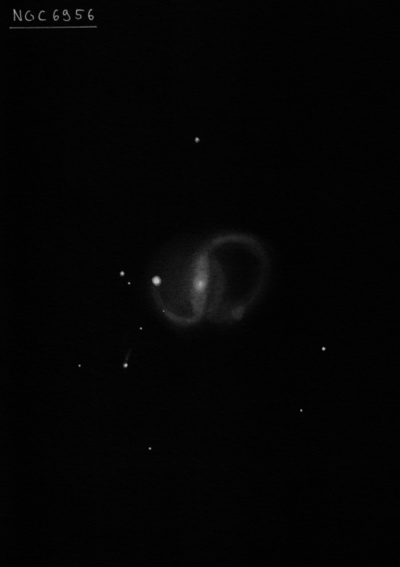
William Herschel discovered NGC 6956 = H III-219 = h2086 on 19 Oct 1784 (sweep 299) and noted "eF; vS; stellar; just preceding a small star, 240 verified it with difficulty." JH made a single observation and recorded "vF; S; 15" precedes and is attached to the double star No. 1566 of my 4th catalogue." His position for HJ 1566 matches the two stars mentioned in my 24" observation, altlhough the WDS identifies a pair that is off the east side of UGC 11620.
200/250mm - 8" (7/16/82): faint, small. A mag 10 star at the east edge interferes.
300/350mm - 13" (6/29/84): faint, diffuse, even surface brightness, possibly slightly elongated E-W. A mag 10.5 star is attached at the east edge 26" from center and detracts from viewing. Brightest of three with UGC 11620 6.7' SSE and UGC 11623 8.0' E.
400/500mm - 17.5" (10/13/01): this moderately bright glow appears unusual as a mag 10.5 star is attached at the east side and interferes with viewing. The surface brightness of this barred spiral is pretty uniform except for a faint stellar nucleus. A mag 14 companion star (double) follows the brighter star. Brightest in a trio with UGC 11620 and 11623 situated 7' SSE and 8' ESE, respectively.
600/800mm - 24" (8/5/13): moderately bright to fairly bright, moderately large, elongated ~3:2 NW-SE, 60"x40". The view is somewhat hampered by a mag 11 star that is superimposed on the east edge and a mag 14.5 star is ~20" E of the bright star. This galaxy appears to be a barred spiral with a brighter bar oriented ~N-S extending down the middle of the glow. The brighter nucleus is quasi-stellar (~5") and similar to the mag 14.5 star in brightness. A faint extension (spiral arm) curves east from the south end of the bar, extending south of the mag 11 star. Brightest in a trio (KTG 71) with UGC 11620 6.9' SE and UGC 11623 8.1' E. Located in a rich Milky Way star field 3.7' SSW of a mag 9.6 star. UGC 11620 appeared faint/fairly faint, small, elongated 3:2 SSW-NNE, 21"x14". Two mag 13/14 stars are off the SE end and a mag 15.5 star is near the NNE end [22" from center]. UGC 11623 is fairly faint, fairly small, elongated 5:3 SW-NE, 36"x20", a small brighter core is embedded in a fairly smooth halo. A small trio of mag 13/14.5.15 stars is close preceding.
Notes by Steve Gottlieb